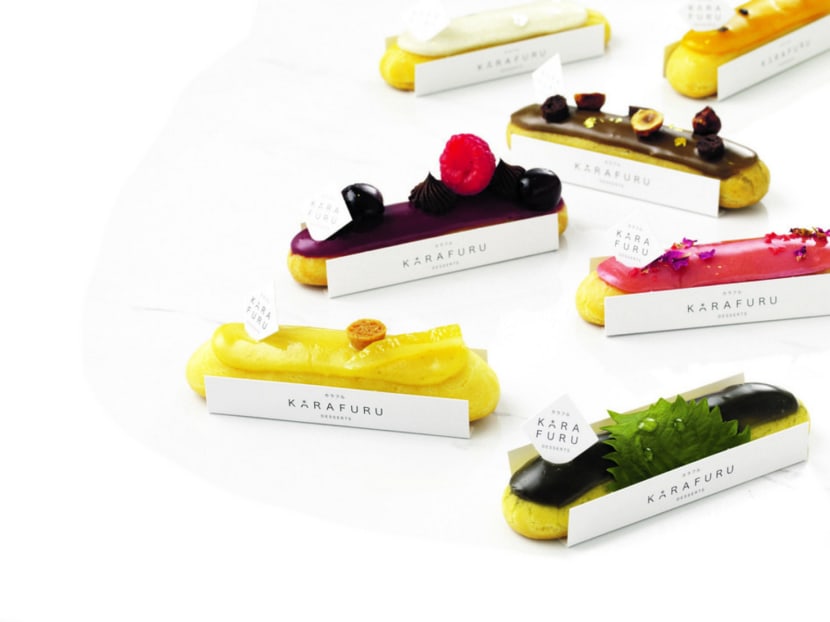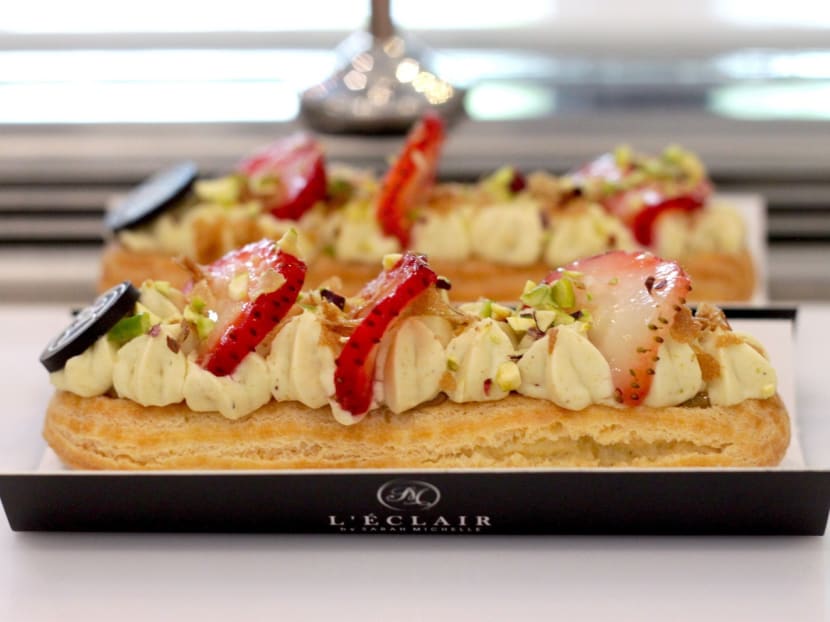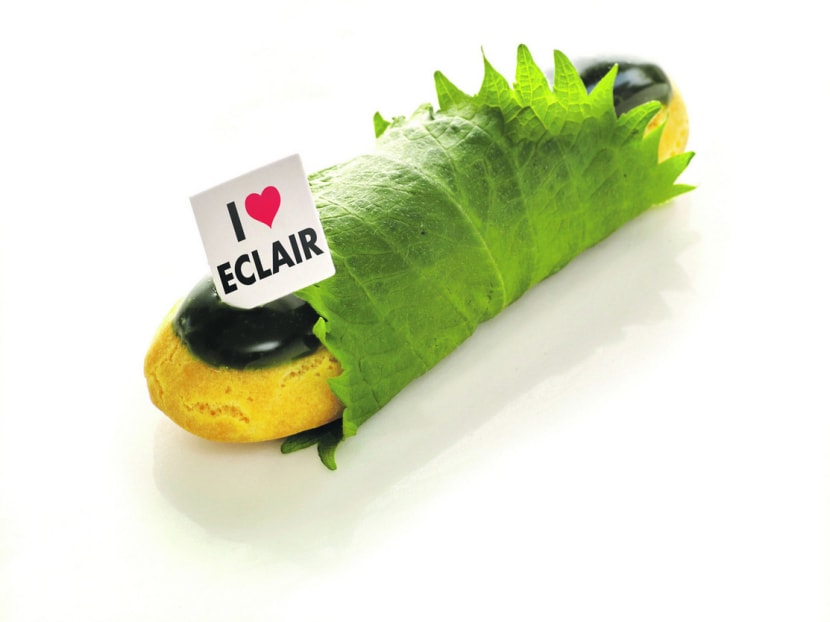Why eclairs are all the rage in Singapore
Who would have thought that the humble eclair once available in less than a handful of flavours — more often than not in chocolate, coffee and vanilla — would go on to inspire a global revolution of sorts?




Who would have thought that the humble eclair once available in less than a handful of flavours — more often than not in chocolate, coffee and vanilla — would go on to inspire a global revolution of sorts?
One can credit French pastry chef Christophe Adam and his recent success in taking the classic French pastry born in the days of Marie Antoinette to new heights, reinventing both its looks (using vibrant, glossy hues even Warhol would have been jealous of) to its near-limitless interpretation of flavours. This has led many to declare the eclair “the new macaron” in terms of its popularity.
The fad has also arrived on our sunny shores; and this has led to two concept stores taking root in the past six months: L’eclair by Sarah Michelle on Clemenceau Avenue, and the one-month-old Karafuru Desserts on Jalan Klapa near Arab Street, headed by pastry chef Michael Liu. While both boast some creative flavour combinations, L’eclair seems to be grounded by distinctly Parisian sensibilities, while Karafuru Desserts champions lighter but no less indulgent Japanese-inspired eclairs.
“I think Singaporeans are generally quite well-travelled and well-informed,” said L’eclair’s Sarah Tan. She and co-founder Michelle Looi went to Paris to train at Le Cordon Bleu for a year in 2013 where they developed a taste for creative eclairs.
“Certainly those who have been to Paris or Europe would have encountered the eclair phenomenon,” she mused, adding that the decision to launch a speciality store was partly based on the idea that it would help them stand out in the growing crowd of pastry shops.
“On the practical side of things, running a specialty shop helps us to streamline operations and allows us to become better and faster at what we do,” she added.
Given the eclair’s more versatile nature (unlike the macaron, it is not held back by a dependence on a lot of sugar), some have argued that it might just have the legs to outlast the macaron fad.
“The versatility of the eclair as a flavour carrier surpasses that of the macaron,” said Joseph Koh, a partner and director at Karafuru Desserts. He thinks that having a world-famous name behind it — like the macaron does in Pierre Herme — may not be necessary.
“It works both ways; a famous name will certainly help in market visibility and ascension. Likewise, a dark horse may also garner attention,” he explained, referring to Karafuru’s unique take on Franco-Japanese pastries. “Most importantly, it should taste as good as it looks; that’s a universal winner.”
He also pointed out how consumers today are seeking out not only deliciousness but also beauty. “Perhaps that is why the macarons and eclairs have much intrinsic room for aesthetic appreciation,” he shared.
NOT TOO INDULGENT
Chefs here have little trouble finding inspiration in the eclair. “It is a seemingly simple pastry that takes a lot of technique and skills to perfect,” said Les Amis’ Cheryl Koh. Her specialty store Tarte By Cheryl Koh also features eclairs — albeit the traditional petit four variety, known as carolines, which are usually about 6cm in length. “They are usually served with coffee and tea, or as a snack ... and its original flavours are chocolate and coffee,” she explained.
Two months ago, though, Tarte featured a range of carolines in eight popular flavours, including hazelnut, salted caramel, lemon meringue, pistachio and chestnut. Today, the choices are limited to a chocolate or vanilla pastry cream filling (priced at S$2.50 each or S$18 for a box of eight).
“We change our selection of tarts and carolines frequently. We introduce new flavours based on seasonal ingredients available and to keep things fresh at Tarte,” she said. “The traditional chocolate flavour is made with a dark chocolate cream with no added sugar, and glazed with a smooth dark chocolate ganache. The vanilla caroline is piped with vanilla pastry cream, topped with a crunchy ‘craquelin’,” she explained.
Late last year, top pastry chef Janice Wong marked the launched of her eponymous roving sweets shop with a few novel eclair varieties, featuring flavours such as peanut butter caramel, tiramisu, popcorn and chocolate truffle (dark chocolate piqued with a hit of actual truffle). Like many of today’s bespoke pastries, these don’t come cheap, priced between S$8 and S$12 for a petite-sized eclair, but fans have said they are worth the splurge.
“Flavour-wise, there are loads of possibilities,” said Tan. “Local flavours such as kaya; converting popular cakes (such as tiramisu and strawberry shortcake) into an eclair; savoury eclairs might be possible too.”
HOW MUCH IS TOO MUCH
L’eclair’s current assortment include classics such as dark chocolate (with 66 per cent Mexican dark chocolate cream) and Ispahan (light rose cream with lychee and raspberries), as well as creative nods to more familiar flavours such as the new Pineapple Ginger eclair. Its eclairs are priced between S$7.50 and S$8.50, which Tan said are “maybe below average” based on “international standards”. “The standard size in Europe is about 12cm in length with a 3cm width, and they go for €6.50 to €7.50 (S$10 to S$11). In Australia, well-known shops like Burch & Purchese Sweet Studio sell eclairs at A$9 (S$9.02).”
Koh added: “We feel S$12 might be a little steep for eclairs, unless there are real truffle shaving (and such) on it! That said, price is subjective, and the worthiness attached to it varies from person to person; as long as the little indulgence makes you happy, then it’s priceless.
“At Karafuru, every one of the 12 flavours is aesthetically designed and decorated with an assortment of sables, creme, candied peels and glazes. Each is painstakingly put together by hand. As far as we know, our eclairs — priced between S$6 and S$7 each — aren’t the cheapest, but we’re not the most expensive; it’s reasonably priced.”
Its assortment also stands out as lighter options, at least where the choux pastry is concerned, with uniquely Japanese flavour combinations such as its Ume Shiso, which is filled with umeboshi (pickled plums) creme and wrapped in a shiso leaf. There are also eclairs with sakura rose cream and marzipan; yoghurt cream topped with pistachio sables, strawberries and raspberries; and yuzu creme with candied lemon, marzipan and ginger sables. So maybe the eclair’s bite-sized stature is a good thing, given that there are, quite simply, so many different ones to try.
Tan added that it is still too early to say if the eclair trend will continue to gain momentum, but she is confident that the eclair has the potential to outperform the macaron.
“I think the macaron fad didn’t really have as good a run in Singapore as it did in Europe and other countries ... perhaps it is due to the fact that many Singaporeans do not appreciate overly sweet pastries,” she said, adding that it will be a while before the eclair bubble reaches bursting point, or go the way of the cupcakes.
“The trend in Europe started in 2012, propelled by Christophe Adam’s unique creations, and it is still going (strongly) today. As a classic French pastry, it has had a really long run. The oldest pastry shop in Paris — Stohrer, which was established since 1730 — is still well known for its classic eclairs. I believe the modernised eclair with its sexy new look should be able to have a good, long run as well,” said Tan.





